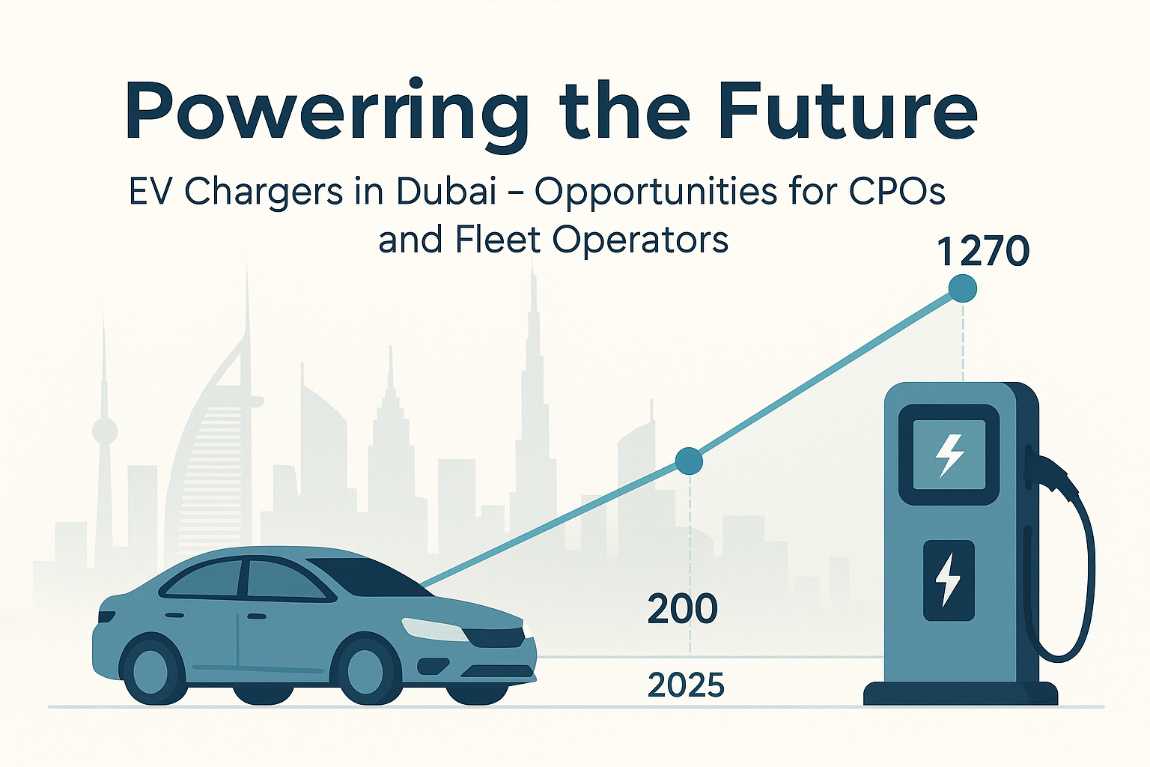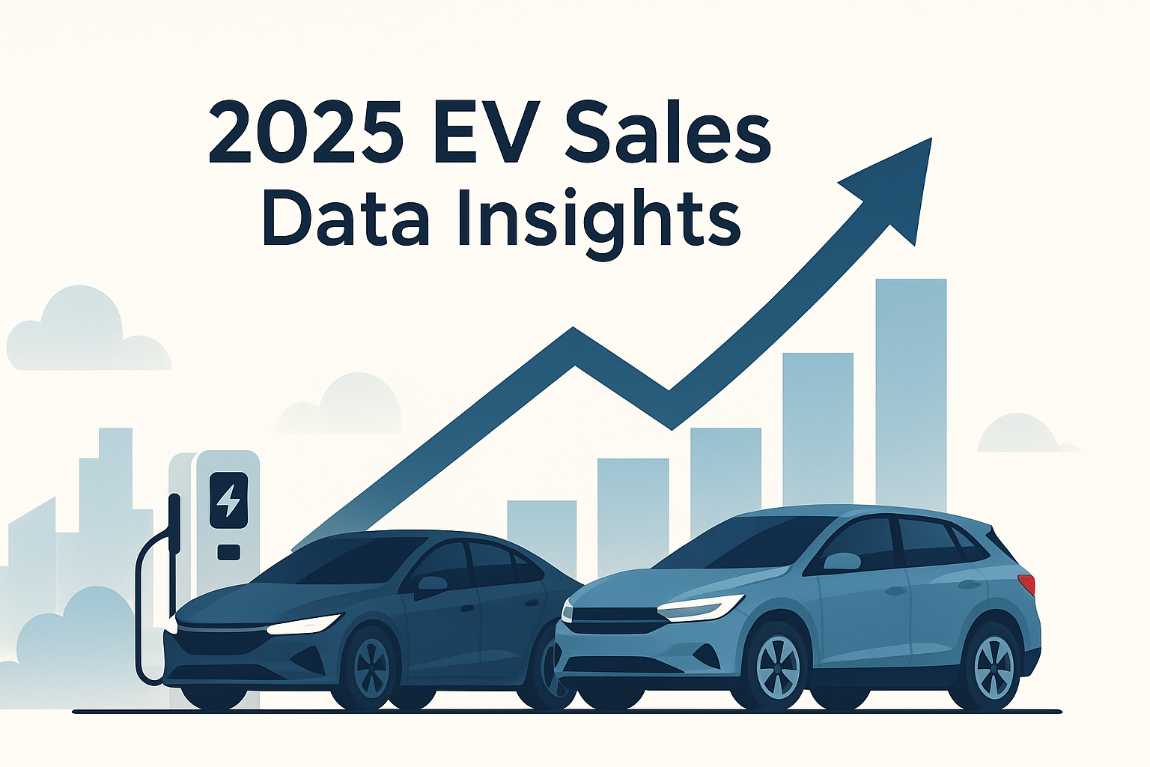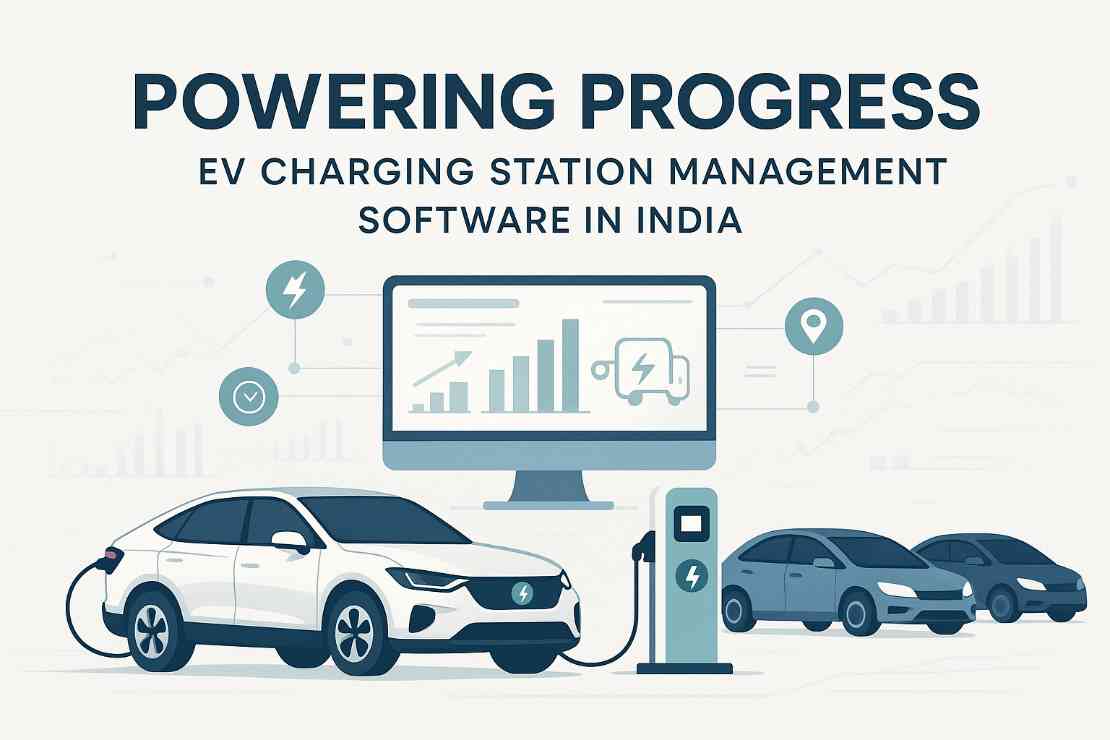Dubai’s push toward sustainable mobility has moved far beyond vision statements. Rapid growth in electric-vehicle adoption, a supportive regulatory environment and an expanding public-private network of charging facilities are turning the emirate into a benchmark for the wider Middle East. Whether you operate a public charging network or manage a large fleet, understanding how Dubai builds, regulates and incentivises its EV infrastructure will help you capture value in a market that rewards early movers.
Expansion of EV Charging Infrastructure in Dubai
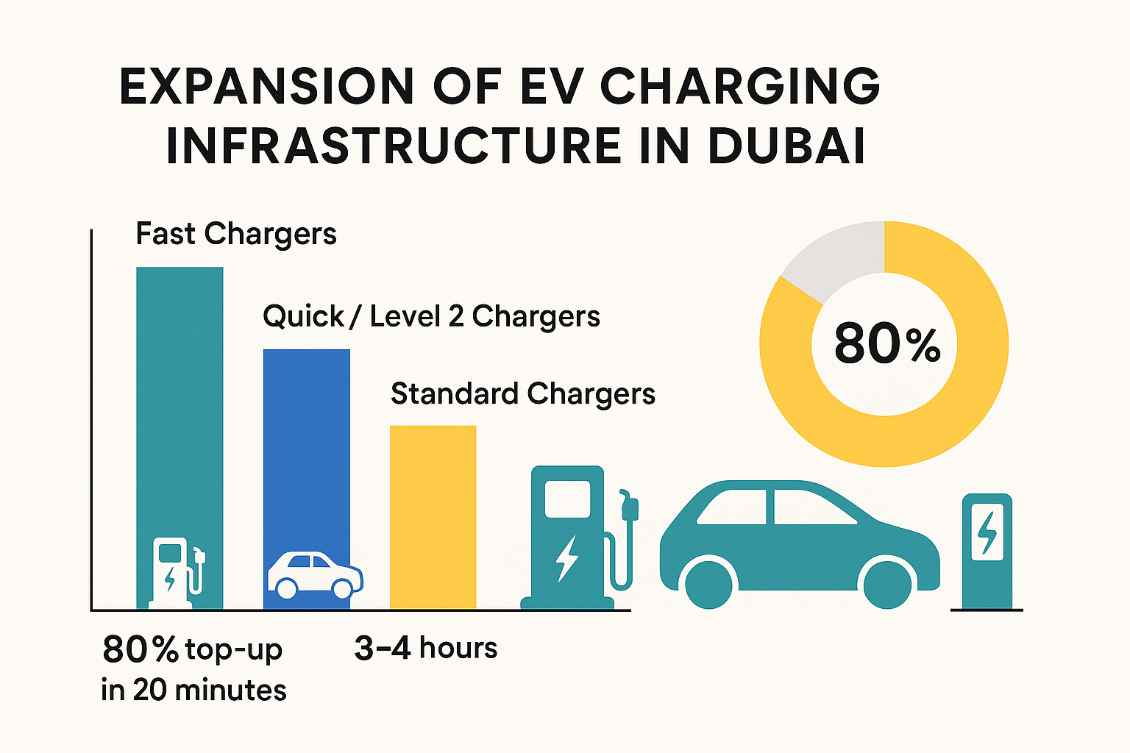
Dubai leads the UAE’s sustainability drive, and its charging landscape reflects that ambition. More than 200 public charging stations dotted the country in 2021, and new connectors continue to appear in government car parks, retail destinations, logistics hubs and residential developments. The Dubai Electricity and Water Authority (DEWA) launched the EV Green Charger initiative back in 2015 with the straightforward goal of ensuring that distance anxiety never becomes a barrier to electrification.
For you, the key message is momentum. Year-on-year additions to the network translate into a compound increase in charging events, energy throughput and recurring revenue. Yet growth without a plan can quickly expose weaknesses, so it is worth mapping out the distinct charger classes you intend to deploy:
• Fast Chargers deliver an 80 % top-up in roughly 20 minutes and suit high-turnover locations such as motorway service areas or taxi ranks.
• Quick Chargers (often labelled Level 2) replenish most passenger cars in three to four hours, ideal for workplaces or destination retail.
• Standard Chargers cater to overnight or long-dwell parking and remain the lowest-cost entry point for landlords easing into EV support.
Ignoring this hierarchy can lead to misallocated capital—installing slow chargers at high-traffic forecourts, for instance, throttles utilisation rates and frustrates drivers. A structured deployment, on the other hand, lets you balance capex, uptime guarantees and user expectations while supporting Dubai’s wider objective of seamless green mobility.
Government Initiatives and Incentives
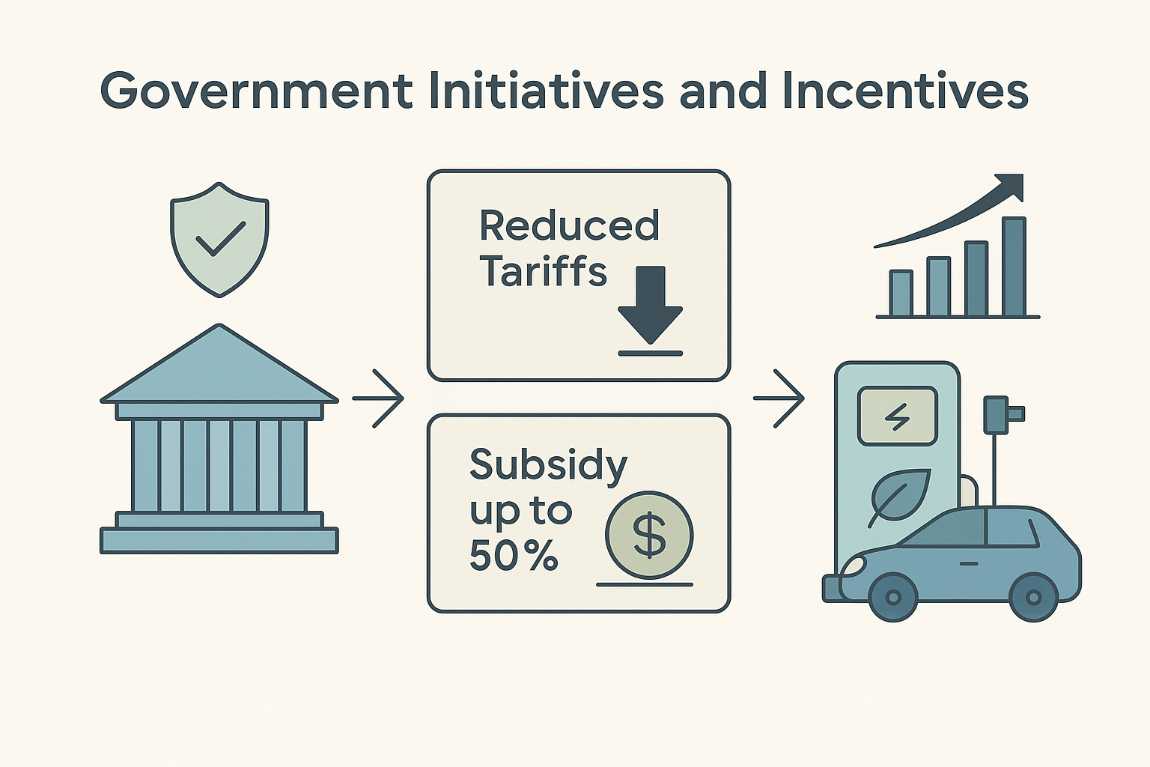
Public policy sits at the heart of Dubai’s EV success. DEWA’s EV Green Charger initiative provides the core infrastructure, but a wider package of incentives encourages both operators and drivers to participate.
Reduced electricity tariffs for registered charge points lower your operating costs and create room for competitive retail pricing or bundled fleet packages. Financial assistance programmes can subsidise a portion of installation expenses, easing the hurdle of procuring switchgear, transformers or civil works.
Regulatory compliance remains non-negotiable. Dubai Municipality and DEWA require adherence to local electrical codes, fault-current calculations and meter-integration standards before a charger can be energised. Skipping any step risks costly rectification works or even disconnection. Allocate time for approvals, and build relationships with accredited contractors who understand the nuances of earthing, load balancing and smart-meter interfaces.
CPOs frequently overlook the need to refresh their incentive knowledge base. Tariffs, subsidies and import duties can shift each budget cycle, and outdated assumptions wreak havoc on payback models. Establish a review calendar—or engage an energy advisory firm such as Pulse Energy—to track policy updates and secure every available cost advantage.
Strategic Partnerships and Technological Advancements
Scale in Dubai often arrives through collaboration. A recent agreement between a leading Indian power-systems manufacturer and a Dubai-based automotive group illustrates how technology transfer and local market access combine to accelerate network rollout. Under a sole-distributorship framework, the partners plan to introduce both AC and DC chargers across the Middle East and Africa, targeting revenue of about USD 50 million within two years.
From your perspective, three lessons emerge:
1. Align commercial and sustainability goals. Partners who share a vision for carbon-neutral transport move faster than those chasing short-term sales.
2. Leverage complementary strengths. Combining hardware expertise with on-the-ground distribution unlocks procurement efficiencies and shortens installation timelines.
3. Standardise communications. Clear escalation paths for maintenance, software updates and user support prevent the finger-pointing that plagues multi-party ventures.
Technologically, Dubai encourages open protocols and smart-charging features. Dynamic load management helps you maximise existing grid connections by distributing amperage among vehicles instead of oversizing the supply. Remote firmware updates reduce truck rolls, while OCPP compliance ensures interoperability with roaming platforms. By investing in up-to-date chargers now, you future-proof assets against upcoming grid-services revenue streams—such as demand response or vehicle-to-grid pilots—that the emirate is already exploring.
DEWA’s Services for EV Charging

Navigating DEWA’s customer-facing systems is a pivotal milestone for any operator or fleet. The EV Green Charger Card Service consolidates authentication, payment and consumption data into a single platform. Users link the card to their Emirates ID, vehicle registration (Mulkiya) and driving licence, then choose between pay-as-you-go or monthly subscription models.
As a CPO, integrating your backend with DEWA’s portal brings two immediate benefits:
• Faster onboarding. Drivers who already carry the card need no additional RFID or app download to tap into your sites.
• Transparent settlements. Consolidated energy statements remove guesswork around kWh delivered, tariffs applied and VAT liability.
You can register a new charge point online and often receive provisional approval the same day, provided load-flow studies and site drawings are in order. From there, DEWA engineers conduct an inspection, activate the metre and issue the QR code that lists your station on the public charger map.
Operators sometimes forget the human element. Frontline staff should understand how the Green Charger card works, how to reset a charger if authentication fails and where to direct users for lost-card replacements. Training manuals and clear signage go a long way towards minimising queue times and call-centre tickets.
Supporting the Transition to Electric Vehicles
Dubai’s transition strategy rests on convenience. When drivers know they can top up within minutes of any major route, the psychological barrier to ditching internal-combustion engines fades. For fleets, that confidence translates into predictable duty cycles and lower total cost of ownership.
Since 2015, the city has rolled out chargers at government offices, ports, logistics depots and shopping centres—the type of locations where commercial vehicles naturally congregate. A dedicated high-speed network from a well-known global EV manufacturer complements the public grid and demonstrates that private capital can coexist with municipal infrastructure.
Your role is to plug remaining gaps, especially in areas with high freight volumes or extended dwell times. Start by analysing telematics data: dwell-time heatmaps will pinpoint the precise forecourts, depots or warehouses where a 50 kW DC charger would halve idle time.
Affordability also matters. Transparent tariff structures—peak, off-peak and fleet-volume discounts—reduce range anxiety’s cousin: price anxiety. CPOs who ignore pricing complexity risk alienating early adopters and slowing overall EV penetration.
Finally, consider education. Mechanics accustomed to diesel trucks may not grasp kilowatt computations or the difference between CCS2 and CHAdeMO connectors. Switching your technical teams to an EV-ready mindset ensures that every charging session, maintenance visit or roadside assist reinforces confidence in zero-emission transport.
Ready to maximize your EV charging potential in Dubai? Visit pulseenergy.io to explore our innovative charging software solutions that can help you optimize operations and reduce costs.
Frequently Asked Questions
Q1. What is EV charging in Dubai?
EV charging in Dubai refers to the network of public, private and fleet-specific stations that deliver electricity to battery-powered vehicles. Most chargers connect to DEWA’s EV Green Charger platform, which standardises payment and ensures grid reliability across the emirate.
Q2. What is EV chargers in Dubai Mall?
Dubai Mall hosts several DEWA Green Chargers and high-speed connectors installed in prime parking zones. The mix of fast and quick chargers lets shoppers top up while they dine or browse, illustrating how retail destinations integrate charging as a customer-experience enhancer.
Q3. How do I integrate my new depot charger with DEWA’s Green Charger system?
Submit your electrical drawings and load calculations through DEWA’s online portal, install equipment that meets local safety codes and schedule a commissioning visit. Once approved, your station will receive a unique QR code and become visible on DEWA’s public charging map.
Q4. Why should I choose fast chargers over standard chargers for a fleet hub?
Fast chargers minimise vehicle downtime by replenishing most batteries in about 20 minutes, making them ideal for high-utilisation fleets. Although they carry higher upfront costs, the productivity gains and quicker turnaround typically offset the investment.
Q5. My charger occasionally stops mid-session. What advanced diagnostics should I run?
Check for authentication timeouts within the OCPP logs, verify that load-management settings do not exceed site capacity during peak demand and ensure firmware is up to date. Consistent failures at the same state-of-charge level may point to cable-temperature thresholds that require hardware inspection.
Q6. What does it cost to operate an EV charger in Dubai?
Operating costs depend on charger power, utilisation rate and DEWA’s tariff tier. Reduced electricity rates for registered Green Chargers, plus potential installation subsidies, can lower total cost to well below AED 0.30 per kWh, allowing competitive retail pricing while maintaining healthy margins.


